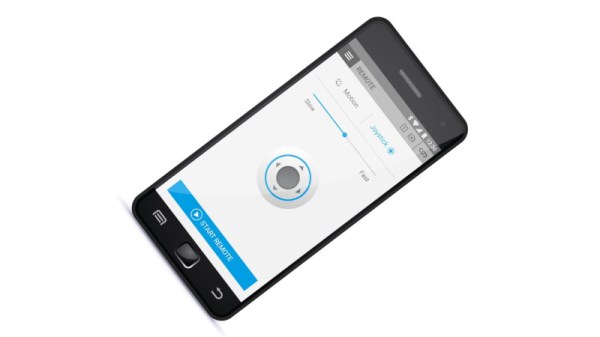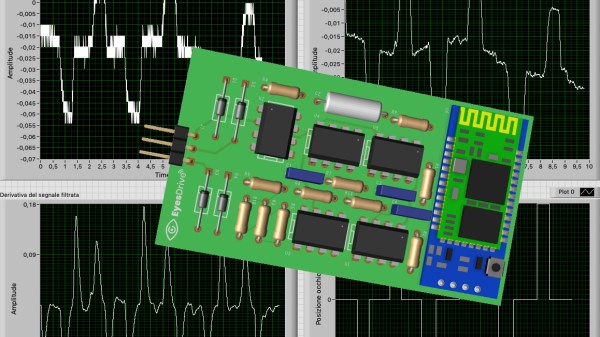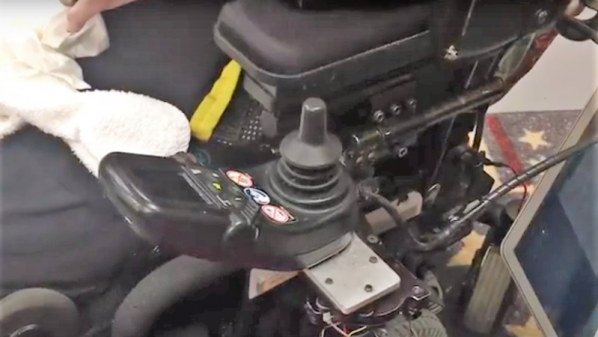The writer Cory Doctorow coined the term enshittification to describe the way that services decline in quality as their users become the product. He was talking about online services when he came up with the word, but the same is very much true when it comes to hardware. Items which once just worked now need apps and online services, with marginal benefit to the user if any. It’s one thing when it’s your soundbar or your washing machine, but thanks to Lemmy user [@win95] from the Netherlands we’ve seen a far more egregious example. People with disabilities are being provided with new powered wheelchairs through their medical insurance, but are then discovering that unaffordable in-app purchases are needed to use their features. Continue reading “The Insurance Buys The Wheelchair, But Not The App To Run It”
WheelChair36 Articles
Karting Hands-Free
Some of us have computer mice with more buttons than we have fingers, resolution tracking finer than a naked eye can discern, and forced-air vents. All these features presuppose one thing; the user has a functioning hand. [Federico Runco] knows that amyotrophic lateral sclerosis, ALS, or Lou Gehrig’s disease, will rob a person of their ability to use standard computer inputs, or the joystick on a motorized wheelchair. He is building EyesDrive for the 2020 Hackaday Prize, to restore that mobility to ALS patients. There are already some solutions, but this one focuses on a short bill of materials.
Existing systems are expensive and often track pupil location, which returns precise data, but EyesDrive only discerns, left, right, and resting. For these, we need three non-invasive electrodes, a custom circuit board with amplifiers, signal processing circuits, and a microcontroller. He includes a Bluetooth socket on the custom PCBs, which is the primary communication method. In the video below he steers a virtual kart around a knotty course to prove that his system is up to the task of an urban wheelchair.
EyesDrive by [Federico Runco] should not be confused with the HackadayPrize2015 winner, Eyedrivomatic, lead by two remarkable hackers, Steve Evans and Patrick Joyce.
Electric Wheelchair Makes A Great Base For A Big Robot
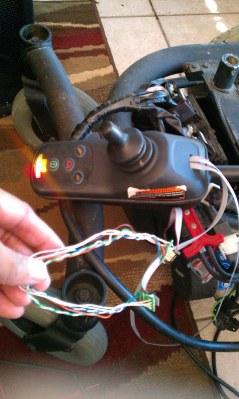
Building robots can be fun, and remains a popular pastime among many in the hacker and maker set. However the hardware side of things can be daunting. This is particularly the case for those attempting to build something on a larger scale. A great shortcut is to start with a robust mechanical platform from the outset – and using an electric wheelchair is a great way to do so.
[Nikita] started this project way back in 2009, after finding a broken electric wheelchair at a flea market. It was no longer in fit condition for use as a wheelchair, so [Nikita] was able to score it for the low price of just $50. That’s a great price for a package which includes a robust chassis, wheels, motors and the required controllers to drive it all. With the platform in hand, it was time to get hacking.
Thus far, [Nikita] has gone so far as to strip the wheelchair of all extraneous parts, leaving it as a motorized carriage. Radio control has been implemented with the help of an Arduino, and a couple of “eyes” have been added to give it a little personality. It can also still be driven with the original joystick, which has been relocated on the chassis. Future plans involve adding a level of autonomy to allow the ‘bot to navigate waypoints and recognise faces, both tasks which should be significantly easier with 2019 technology. We’re eager to see where it goes next; we’ve seen great applications of wheelchair hardware before, after all. Video after the break.
Continue reading “Electric Wheelchair Makes A Great Base For A Big Robot”
On The Right Tracks: Electric Wheelchair Guts Find New Life As Tank
Every hacker has dreamt of building their own tank at some point. Or maybe that’s just us. [Peter Sripol] and [Sam Foskuhl] have built one at a scale which is big enough to be rideable, but small enough that neighbors don’t get concerned.
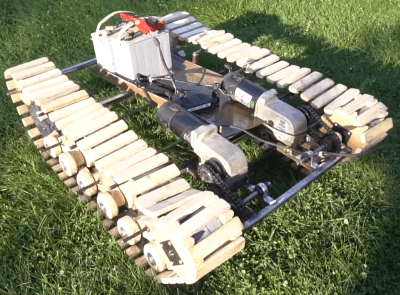
An electric wheelchair is at the heart of the build. After ripping out its internals, the two motors with gearboxes are directly connected to the two tracks, allowing differential steering. Holding everything together is a solid welded steel frame – essential for years of reliable sieging.
The tracks themselves are simple strips of wood, cut and assembled by hand onto a nylon belt. Meanwhile the track wheels and drive assembly are designed in CAD and cut with a CNC router from some plywood, a great choice for adding some precision to the most mechanically challenging part of the build. As always in [Peter]’s videos, a large portion is dedicated to testing – in this case with a rather large array of fireworks. We certainly wouldn’t want to be in his bad books considering his other souped-up weapons.
A small, hacked, novelty electric vehicle? Sounds like it would find some good friends at EMF Camp, especially at the Hacky Racers event.
Continue reading “On The Right Tracks: Electric Wheelchair Guts Find New Life As Tank”
Rapidly Prototyping Prosthetics, Braille, And Wheelchairs
We live in an amazing time where the availability of rapid prototyping tools and expertise to use them has expanded faster than at any other time in human history. We now have an amazing ability to quickly bring together creative solutions — perfect examples of this are the designs for specialized arm prosthetics, Braille printing, and custom wheelchair builds that came together last week.
Earlier this month we published details about the S.T.E.A.M. Fabrikarium program taking place at Maker’s Asylum in Mumbai. The five-day event was designed to match up groups of makers with mentors to build assistive devices which help improve the condition of differently-abled people.
The participants were split into eight teams and they came up with some amazing results at the end of the five-day program.
Hands-On: Prosthetic Designs That Go Beyond
Three teams worked on projects based on Bionico – a myoelectric prosthesis
DIY Prosthetic Socket – a Human Machine Interface : [Mahendra Pitav aka Mahen] lost his left arm during the series of train bomb blasts in Mumbai in 2006, which killed 200 and injured over 700 commuters. He uses a prosthetic arm which is essentially a three-pronged claw that is cable activated using his other good arm. While it is useful, the limited functionality restricted him from doing many simple things. The DIY Prosthetic socket team worked with [Mahen] and [Nico Huchet] from MyHumanKit (who lost his right arm in an accident 16 years back), and fabricated a prosthetic forearm for [Mahen] with a modular, 3D printed accessory socket. Embedded within the arm is a rechargeable power source that provides 5V USB output at the socket end to power the devices that are plugged in. It also provides a second port to help recharge mobile phones. Also embedded in the arm was an IR reflective sensor that can be used to sense muscle movements and help trigger specific functions of add-on circuits, for example servos.
Continue reading “Rapidly Prototyping Prosthetics, Braille, And Wheelchairs”
S.T.E.A.M. Fabrikarium Builds Assistive Tech In Mumbai
Starting this weekend, a group of 65 invited Maker’s from various disciplines, along with 20 awesome Mentors, will gather at the Maker’s Asylum in Mumbai for the five day S.T.E.A.M. Fabrikarium program. The aim is to improve the capabilities of the differently-abled by building and expanding upon existing open source projects. At the same time, the teams will learn more about rapid prototyping techniques.
Among the participants will be at least 15 differently-abled people who will be a part of the whole process of learning as well as providing their inputs on the problems being tackled. Participants have an opportunity to understand how design thinking works and work on improving the existing designs.
Participants will team up and choose from five existing open source projects:
- Bionico – a myoelectric prosthesis
- Braille rap – using a 3D printer as a braille embosser.
- e-Trotti – a low-cost, removable electrical assistance for wheelchair use, made from electric scooter parts.
- Project Shiva – customized and beautiful upper limb prosthetics.
- Flying Wheelchair – a wheelchair specially adapted for use while paragliding.
The Asylum’s fully-fledged workshop facilities offer a wood shop, a laser cutter, a CNC, several 3D printers, electronics tools and instruments and an infectious environment that will allow the participants to learn a lot during the five short days. While working on prototyping their projects, all teams will have constant access to a team of mentors and industry experts who will help solve their problems and give guidance when necessary.
The Maker’s Asylum includes fully-fledged workshop facilities for the build process, and the team succeeded in bringing onboard a slew of industrial partners and supporters to ensure that the program can be offered to the participants for free. That is a great way to bring makerspaces, makers, and the industry together in a symbiotic program that benefits society. The program was developed in collaboration with My Human Kit, a company from France who selected the five open-source projects mentioned above. The Fabrikarium is made possible via Bonjour-India, which fosters Indo-French partnerships and exchanges.
Hackaday is proud to be a part of this program and will be present to help document all of the awesome projects. Participants will share their progress on Hackaday.io, so watch for updates over the coming week. To get an idea of what to expect at the S.T.E.A.M. Fabrikarium 2018, check out the video from an earlier version embedded below.
Continue reading “S.T.E.A.M. Fabrikarium Builds Assistive Tech In Mumbai”
Retractable Console Allows Wheelchair User To Get Up Close And Personal
[Rhonda] has multiple sclerosis (MS), a disease that limits her ability to walk and use her arms. She and the other residents of The Boston Home, an extended care facility for people with MS and other neuromuscular diseases, rely on their wheelchairs for mobility. [Rhonda]’s chair comes with a control console that swings out of the way to allow her to come up close to tables and counters, but she has problems applying enough force to manually position it.
Sadly, [Rhonda]’s insurance doesn’t cover a commercial solution to her problem. But The Boston Home has a fully equipped shop to extend and enhance residents’ wheelchairs, and they got together with students from MIT’s Principles and Practices of Assistive Technology (PPAT) course to hack a solution that’s not only useful for [Rhonda] but should be generally applicable to other chairs. The students analyzed the problem, measured the forces needed and the clearances required, and built a prototype pantograph mount for the control console. They’ve made the device simple to replicate and kept the BOM as inexpensive as possible since patients are often out-of-pocket for enhancements like these. The video below shows a little about the problem and the solution.
Wheelchair hacks are pretty common, like the 2015 Hackaday Prize-winning Eyedrivomatic. We’ve also covered totally open-source wheelchairs, both manual and electric.
Continue reading “Retractable Console Allows Wheelchair User To Get Up Close And Personal”

